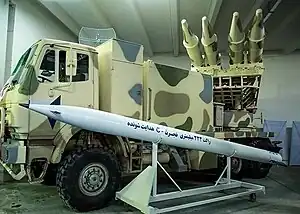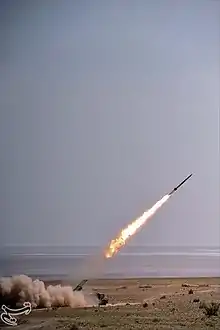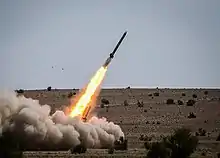Fajr-5
The Fajr-5 (rarely Fadjr-5, Persian: فجر-۵, "Dawn") is an Iranian 333 mm long-range multiple launch rocket system (MLRS). The Fajr-5 was developed during the 1990s and has since been exported to various armed actors in the Middle East.
| Fajr-5 | |
|---|---|
 A Fajr-5C GPS guided surface-to-surface missile, seen in front of the Fajr-5 MLRS on a Mercedes Benz 2631 chassis | |
| Type | Rocket artillery |
| Place of origin | Iran |
| Service history | |
| Used by | See Operators |
| Wars | Israeli–Palestinian conflict Syrian Civil War |
| Production history | |
| No. built | somewhere around 100 systems[1] |
| Specifications | |
| Mass | 15,000 kg (launcher, empty)[2] 90 kg (HE content) 175 kg (warhead) 915 kg (rocket)[3] |
| Length | 10.00 m (launcher)[lower-alpha 1] 6.485 m (rocket)[2] |
| Width | 2.5 m (launcher)[2] |
| Height | 3.34 m (launcher)[3] |
| Caliber | 333 mm |
| Elevation | 0 to 57 degrees[3] |
| Traverse | 45 degrees left and right[3] |
| Rate of fire | 4–8 seconds[3] |
| Effective firing range | 68–75 km |
| Maximum speed | 1,100 m/s (max)[2] |
The Fajr-5 launcher fires four 6.48 meter long, 333 millimeter-calibre Fajr-5 artillery rockets, with a range of 75 kilometers (50 mi), weighing 915 kilograms each and carrying 175-kg fragmentation warheads with 90 kg of high explosive (HE). Most Fajr-5 rockets are unguided; in 2017 Iran introduced a variant, the Fajr-5C, which adds GPS guidance.
The Fajr-5 is primarily used by the Iranian Army Ground Force to attack large, fixed, high-value targets, like airfields and military bases.[2] In addition, the system is also used by militant groups to target Israel. Finally, the system has a niche role in use by the IRGC-N as an unguided anti-ship rocket system for the Persian Gulf.
Design
MLRS

The Fajr-5 artillery rocket system is installed on a Mercedes Benz 2631 6×6 forward control chassis.[4] To provide a stable firing platform, four hydraulically operated stabilizers are lowered to the ground before firing.[4] Another fully enclosed cabin to the immediate rear of the cab houses the remainder of the crew. This new chassis was unveiled in 2006;[4] some systems have not been upgraded and are still on older chassis.
The Fajr-5 is normally fired from this truck launcher, but it can also be fired individually.[5] The primary role of this artillery rocket system is the engagement of land targets. A naval surface search radar can be added to allow the system to be used in an anti-shipping role.[1]
Fajr-5 MLRS can be networked together,[1] and have a remote-fire capability in which the command vehicle can fire all nearby Fajr-5 systems.[1]
The Fajr-5's circular error probable (CEP) is not known.[1] The Fajr-5's reliability is not known. The Fajr-5's cost is not known. The number of Fajr-5 rockets produced is not known. Whether the Fajr-5 is still in production is not known.
In 2019, the Defense Intelligence Agency described the Fajr-5 as the "most capable" multiple rocket launcher in Iranian service.[6]
Basic rocket

The rocket is solid fueled and has a fragmentation high explosive warhead.[2] The rocket is 6.485 meters long, 333mm in diameter, and weighs 907 kg.[2] It has wraparound fins for stabilization in flight, which reach a diameter of 710 mm when extended.[2] The rocket's double base propulsion burns for an average time of 5.3 seconds, reaching a peak velocity of 1100 m/s.[2] The rocket's motor has nine launch nozzles arranged in a circle, which are slanted to help create spin-stabilization in flight.[7] The Fajr-5 rocket carries a 175 kg warhead with a fragmentation radius of 500m.[2]
One source reports that Fajr-5 rockets can likely carry (plain) high explosive, submunitions, incendiary, smoke, or chemical payloads as well.[1] The shelf life of a basic Fajr-5 rocket is 15 years.[2]
Two-stage rocket
Iran produces a two-stage Fajr-5 rocket with extended range. The two-stage Fajr-5 rocket has a length of 9.4 m and a maximum range of 180 km at sea level.[2] This variant has a diameter of 333 mm, like other Fajr-5 rockets, but has fixed fins, which have a diameter of 561 mm.[2] The two-stage Fajr-5 can reach a maximum altitude of 85 km and carries the same 175 kg warhead with a 500m fragmentation radius.[2] This variant is launched from TELs similar to those used for Zelzal rockets, which only have the capacity for a single rocket.
The shelf life of a two stage Fajr-5 rocket is 15 years.[2]
Fajr-5C
In February 2017, Iran revealed a guided version of the Fajr-5, similar to the Chinese SY300, under the name Fajr-5C. It has a firing accuracy of 250 m when using INS and 50 m using GNSS, with range from 40–130 km (25–81 mi).[8]
The guided Fajr-5 rocket was briefly mentioned, and believed to be under development, in 2014.[9] The missile has been delivered to the IRGC Ground Force units as of May 2023.[10]
GR110/GF5LR1
In August 2023, Iran revealed a new version of the Fajr-5 at the Ministry of Defense Industry Authority Exhibition 1402.
It has a maximum range of 110km and a weight of 902kg with a warhead weighing 115kg while achieving an accuracy of 25m CEP.
Reloading
When the Fajr-5 is reloaded, the launch tubes (in two groups of two) are detached from the launcher and laid on the ground by a crane (an Italian Effer 155-25). Then, a machine called a "Loading machine" is used to mechanically press the heavy Fajr-5 rockets into their launch tubes one by one. When all the tubes are filled, the crane is used to reattach the launch tubes to the vehicle.[2] Because of the long reload time and large size of the "Loading machine" (12m), the Fajr-5 MLRS is supposed to retreat after firing to safer rear battle areas to reload.[2] A reload takes 2 minutes per rocket.[2]
History

The first Fajr-5 were created when China exported WS-1 MLRS to Iran in the late 1980s/early 1990s.[11] They were then subsequently created and produced by Iran's Aerospace Industries Organization.
Operational history
Iran
As of 2011, the best estimate for the number of Fajr-5 pieces manufactured was "somewhere around 100" or less.[1]
Lebanon
Iran supplied a number of Fajr-5s to Hezbollah in Lebanon beginning in 2002[12][13] or 2001.[14] Sources disagree on whether Hezbollah used Fajr-5 rockets in the 2006 Lebanon War,[15] in part because at the time they were confused with similar Khaibar-1 rockets.
Palestinian territories
Fajr-5 rockets are held in the Gaza strip by Palestinian militant groups. The first was fired by Hamas in November 2012.[16] It is believed that manufacture of some sub-components and final assembly may take place in Gaza, but that the critical components of the rocket are furnished by Iran.[7] Iran denied transferring any rockets to Gaza but said they instead transferred technology to manufacture the rocket.[17]
Some Palestinians have named their children after the Fajr-5.[18]
Pillar of Defense
In November 2012 during Operation Pillar of Defense, Hamas and Palestinian Islamic Jihad fired Fajr-5 rockets towards Tel Aviv and Jerusalem. One hit an apartment block in Rishon LeZion. At least 14 rockets were fired in total.[7]
Syria

On May 10, 2018, the IRGC's Quds Force fired 20 rockets into the Israeli-occupied Golan Heights from Syrian territory. Some of these were Fajr-5s.[19]
In December 2018 some Fajr-5 rockets were destroyed in an IAF airstrike.[20]
Iraq
Sporadically, during the US occupation of Iraq (between 2003 and 2011), Iranian Backed militias fired the 333 Fajr-5 at US forces from fabricated rails. In 2015, Iran sent Fajr-5 rockets and launcher systems to Iraq to be used in the War against the Islamic State. It is unknown if they were fired, and the quantity sent is also unknown.[21]
Yemen
The Houthis have unveiled a rocket with similarities to the Fajr-5.[22]
Operators

Current operators
Former
References
- Galen Wright (March 15th 2011) Iranian Military Capability 2011 - Ground Forces
- "Defense Industries Organization 2013 Catalog, Section 3: Rocket Industries Group" (PDF). Archived from the original (PDF) on 2013-08-10.
- Fajr-3 & Fajr-5 brochure. Archived 2008-01-14 at the Wayback Machine Retrieved on May 13, 2008.
- Foss, Christopher F (8 May 2006). "Fadjr-5 artillery rocket system gets new chassis". Kuala Lumpur: Jane's Information Group. Archived from the original on 14 June 2006. Retrieved 2006-07-30.
- Anthony H. Cordesman, Martin Kleiber. Iran's Military Forces and Warfighting Capabilities (2007) ISBN 978-0-89206-501-1 p.60–61
- Iran Military Power (PDF). Defense Intelligence Agency. 2019. p. 75. ISBN 978-0-16-095157-2.
- "Hamas' Rocket of Choice". Stratfor. Jul 9, 2014. Archived from the original on December 17, 2018. Retrieved December 17, 2018.
- "Iran unveils new Fajr 5 300mm MLRS Multiple Launch Rocket System using guided rockets 10702171". armyrecognition.com. 7 February 2017. Archived from the original on 10 February 2017. Retrieved 8 February 2017.
- "IRGC unveils new tactical ballistic missiles developments - IHS Jane's 360". 14 July 2014. Archived from the original on 14 July 2014.
- "IRGC Tests Homegrown Rocket with Thermobaric Warhead - Politics news". Tasnim News Agency.
- "Military Briefing on Hezbollah's Missile Capabilities: Examining the Fajr, Zelzal". Vital Perspective. Jul 18, 2006. Archived from the original on November 16, 2006. Retrieved March 1, 2019.
- Devenny, Patrick (1 January 2006). "Hezbollah's Strategic Threat to Israel". Middle East Quarterly. Archived from the original on 19 March 2018. Retrieved 5 October 2018.
- Gordon, Michael (September 27, 2002) "Militants Are Said to Amass Missiles in South Lebanon". The New York Times.
- Sammy Salama; Nikolai Sokov; Gina Cabrera-Farraj (May 4, 2006). "Iran Tests Missiles for Domestic and Foreign Audiences; Origins of One Advanced System Remain Murky". James Martin Center for Nonproliferation Studies. Archived from the original on June 5, 2015. Retrieved 2015-06-04.
- Lambeth, B. S. (2011). Air Operations in Israel's War Against Hezbollah: Learning from Lebanon and Getting it Right in Gaza. Santa Monica, CA, United States: RAND. ISBN 978-0-8330-5146-2
- Jean-Loup Samaan (April 2015). "Another Brick in the Wall: The Israeli Experience in Missile Defense" (PDF). The Letort Papers. U.S. Army War College, Strategic Studies Institute. Archived (PDF) from the original on March 5, 2020.
- "Iran transferred Fajr-5 missile technology to Gaza: IRGC chief". 21 November 2012. Archived from the original on 27 November 2012.
- "Gazans naming newborns after Iran's Fajr-5 missiles". The Iran Project. 9 December 2012. Archived from the original on 17 December 2018. Retrieved 17 December 2018.
- Spyer, Jonathan (7 September 2018). "Israel's Secret War Against Iran Is Widening". Archived from the original on 2018-10-05. Retrieved 2018-10-05.
- Anna Ahronheim (December 27, 2018). "Satellite shows damage to Iranian bases after Israeli Syria strike - Arab-Israeli Conflict - Jerusalem Post". www.jpost.com. Archived from the original on December 28, 2018. Retrieved December 28, 2018.
- Schmitt, Eric (16 March 2015). "Iran Sent Arms to Iraq to Fight ISIS, U.S. Says". New York Times. Archived from the original on 17 December 2018. Retrieved 17 December 2018.
- "Iran-Backed Houthis Launch Ballistic Missile at Saudi Forces". The Tower. 20 November 2018. Archived from the original on 17 December 2018. Retrieved 17 December 2018.
- Mark Pyruz (March 2, 2014). "President Rouhani tours Iran Navy and IRGC Navy bases". Archived from the original on December 17, 2018. Retrieved December 17, 2018.
- "Iran supplies improved rockets to Syria and Hizbullah - Jane's Missil…". Archived from the original on 7 July 2012.
- The older Fajr-5 launcher, on a Mercedes 2624 chassis, has slightly larger dimensions; see the brochure[3]